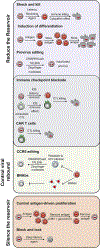The Biology of the HIV-1 Latent Reservoir and Implications for Cure Strategies
- PMID: 32272077
- PMCID: PMC7219958
- DOI: 10.1016/j.chom.2020.03.014
The Biology of the HIV-1 Latent Reservoir and Implications for Cure Strategies
Abstract
Antiretroviral therapy (ART) inhibits HIV replication but is not curative. During ART, the integrated HIV genome persists indefinitely within CD4+ T cells and perhaps other cells. Here, we describe the mechanisms thought to contribute to its persistence during treatment and highlight findings from numerous recent studies describing the importance of cell proliferation in that process. Continued progress elucidating the biology will enhance our ability to develop effective curative interventions.
Copyright © 2020 Elsevier Inc. All rights reserved.
Conflict of interest statement
Declaration of Interests S.G.D. receives grant support from Gilead, Merck, and ViiV. He is a member of the scientific advisory boards for BryoLogyx and Enochian Biosciences and has consulted for AbbVie, Biotron, and Eli Lilly.
Figures



References
-
- Banga R, Procopio FA, Noto A, Pollakis G, Cavassini M, Ohmiti K, Corpataux JM, de Leval L, Pantaleo G, and Perreau M (2016). PD-1 and follicular helper T cells are responsible for persistent HIV-1 transcription in treated aviremic individuals. Nat Med. - PubMed
Publication types
MeSH terms
Substances
Grants and funding
LinkOut - more resources
Full Text Sources
Other Literature Sources
Medical
Research Materials

